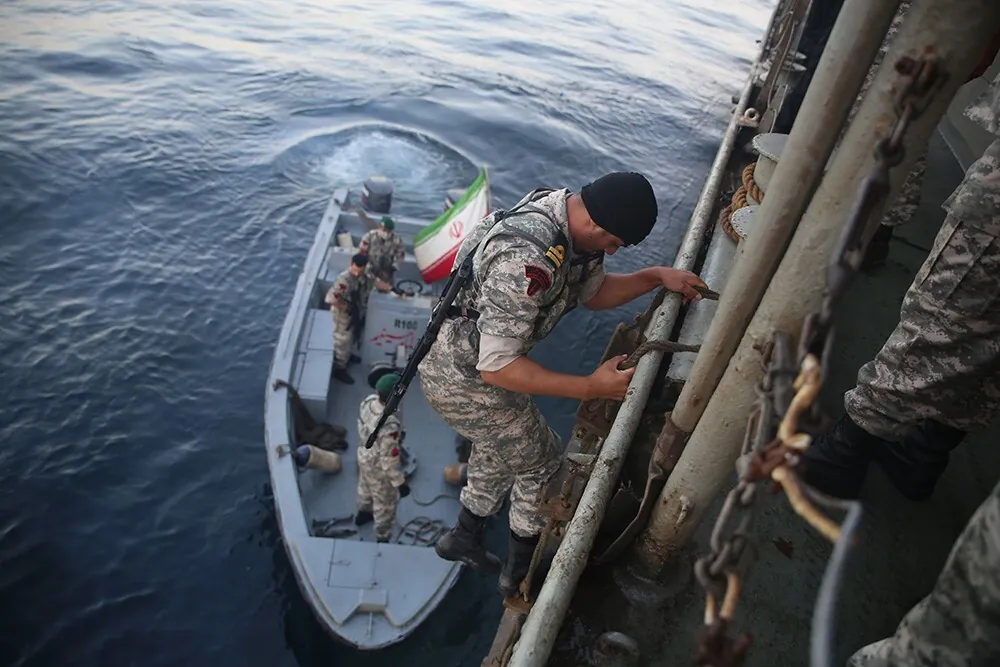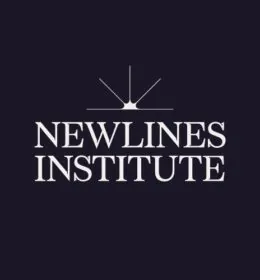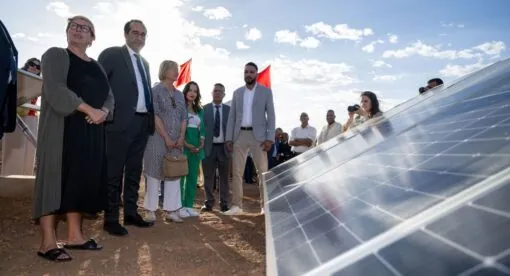Iran’s new forward base ship indicates a shift in the country’s naval priorities and could affect the balance of power between the long-favored Islamic Revolutionary Guard Corps and the Artesh, Iran’s conventional military.
Earlier this year, the Islamic Republic of Iran Navy (IRIN) unveiled its newest — and by far largest — warship during a missile exercise in the Gulf of Oman. According to statements from Rear Admiral Hossein Khanzadi, the head of the IRIN, the Makran — an oil tanker converted to one of the largest military vessels afloat — is a forward base ship with a displacement of more than 100,000 tons capable of carrying and sustaining naval forces far from Iranian waters. Since the Iran-Iraq War, the U.S. Navy has maintained a significant presence in the Persian Gulf. To deter conflict against a superior conventional fleet, Tehran prioritized asymmetric, localized naval forces difficult for the United States’ large surface combatants to repel. However, the conversion of the Makran and its official commissioning in January suggests that Iran is looking to expand its maritime presence abroad to secure sea lines of communication and pursue multinational naval diplomacy.

For most of this century, the combined effects of international sanctions and a persistent U.S. presence in the Persian Gulf limited Iran’s ability to develop — and interest in developing — a world-class navy capable of pursuing its interests abroad. As a result, Tehran prioritized funding for the asymmetric, localized, and low-tech Islamic Republic Guard Corps Navy (IRGCN), which operates the small, fast attack vessels that often capture headlines. However, the recent expiration of the U.N. arms embargo on Iran — and a prevailing sense that the U.S. is “disinterested and disengaged” from the Middle East — offers Tehran a unique opportunity to recapitalize its blue water navy.
The Makran acquisition suggests the beginning of a new push to modernize the aging IRIN fleet, a necessary step to realizing a Shiite Crescent that counters and encircles Iran’s regional rivals. A modernization effort would be significant for three reasons. First, developing the IRIN into a world-class navy requires Tehran to upset the delicate balance of power between the long-favored IRGC and the regular Iranian armed forces, known as the Artesh. Second, multiple reports from the U.S. intelligence community over the past decade claimed that Iran had no intention of building auxiliary ships — like those needed to support the Makran — necessary for long-haul deployments. Third, large ships require large supporting infrastructure, which means the IRIN’s rush to field the Makran may provide insights into Tehran’s highly anticipated Seventh National Development Plan, which is set to be released this year.
The Importance of Forward Base Ships
Satellite imagery of the Makran from its 2020 refit at the Shahid Darvishi shipyard near the Bandar Abbas port indicates that it is now one of the largest military vessels afloat, prompting comparisons to the U.S. Navy’s 100,000-ton Expeditionary Sea Base ships (ESBs). The U.S. military’s ability to operate as a global force depends on its sealift capacity, which enables it to transport and sustain air, ground, and maritime forces across oceans. During the Tanker Wars of the 1980s, the U.S. Navy used ESBs — then called “mobile sea bases” — carrying helicopters, small boats, and special operations forces to strike, board, and scuttle Iranian ships in the Persian Gulf. ESBs allowed the U.S. to transport and sustain naval forces half a world away capable of denying Tehran the ability to operate in its own backyard.

The advantage of an ESB over traditional escorts, such as corvettes, is the speed and range at which the helicopters and fast attack craft they carry can strike. By using the Makran as a forward base ship for patrols and quick reaction forces, Iran has an opportunity to shift the balance of power in its ongoing “shadow war” at sea with Israel.
Analysts claim that the success of Israeli air strikes against Iranian-backed forces in Syria compels Iran to view sea lanes through the Gulf of Aden to the Eastern Mediterranean as a safer alternative to supplying proxies by land. However, just as the maritime commons offer enhanced concealment of Iranian resupply efforts, they also allow Israeli forces to wage guerilla-like warfare against military and cargo vessels.
Last month, Israel demonstrated the success of these tactics against Iranian military targets by mining the Saviz, a covert IRGCN vessel collecting intelligence in the Red Sea. Historically, attacks against largely defenseless support ships are deterred through the deployment of escorts. However, in 2020, Israel demonstrated the ability to strike targets escorted by heavily armed Russian and IRGCN warships when it detonated an explosive device on the Iranian cargo ship Shahr e Kord near Syria. These attacks show how Iran and its allies are currently unable to protect Iranian ships beyond the Gulf of Oman.
According to the Defense Intelligence Agency, the Makran is likely the product of Iran’s lessons learned from the Tanker Wars and recent Israeli attacks: Sea control requires quick-reaction forces. With the ability to carry up to five helicopters and a range of fast attack craft, the Makran could play a key role in securing Iran’s access to the Eastern Mediterranean from covert and conventional threats. This is an important step toward sustaining a Shiite Crescent land bridge, countering Turkey, and encircling regional rivals.
The Makran will give the IRIN the logistical ability to operate farther from the Persian Gulf for greater lengths of time. Geopolitical and budgetary realities mostly limit the IRIN’s out-of-area activity to the “Golden Triangle,” a zone encompassing the straits of Hormuz, Malacca, and Bab el Mandeb. However, since 2009, the IRIN has extended its range as far abroad as South Africa and China through the deployment of “peace and friendship groups” that visit foreign ports to “show the flag” and participate in multinational exercises.

Large, modern auxiliary ships provide the logistical support necessary for a navy to operate far from its shores. Without these ships, a navy lacks the ability to conduct underway replenishments, which limit the need for port calls by refueling and resupplying warships at sea. According to a 2017 report by the Office of Naval Intelligence, Iran’s lack of modern, large auxiliary ships is the primary inhibitor of the IRIN’s goal to become a world-class strategic navy. However, as recently as 2019, the Defense Intelligence Agency assessed that Iran had given no indication it planned to acquire such support ships.
In 2019, the deputy commander of the IRIN — Rear Adm. Touraj Hassani — famously promised that, in response to the U.S. Navy’s continued presence in the Persian Gulf, an Iranian flotilla would soon deploy to the Gulf of Mexico. While the Makran will not singularly enable the IRIN to deploy to American shores, it will allow Iran to bolster its presence where it already operates and extend its reach. With the ability to increase Iran’s presence abroad through distant port calls and multinational exercises, the Makran will likely lower the threshold for conflict in the Eastern Mediterranean and Indo-Pacific.
A Shift in Priorities?
The IRGC is an elite military organization that, as the guardian of the Islamic Revolution from foreign and domestic threats, wields an “outsized role” in Iran’s foreign policy and economy. The IRGC enjoys a direct line to the supreme leader and the support of many senior government officials who cut their teeth in its officer corps. By contrast, the Artesh is a relatively weak conventional military force viewed by ruling conservative hardliners as a relic of the Shah era. On land, the IRGC operates alongside proxies abroad to establish a Shiite Crescent across the Levant, relegating the Artesh to a national guard role. However, these duties are reversed at sea, where the IRGCN operates small, fast attack craft in Iran’s littorals while the IRIN pursues objectives in the Gulf of Oman and beyond.
Despite operating less-expensive ships closer to Iranian shores, the IRGCN traditionally boasts greater manpower and funding than the IRIN. The division of resources between the IRGCN and the IRIN is often cited as an indicator of Tehran’s national security priorities. In pursuit of the funding and acclaim that accompanies the IRGC’s foreign exploits, senior IRIN officials publicly campaign for a rebalancing of priorities. The Makran may be an initial indicator of an effort to rebalance, which is essential to preserving the rivalry between the IRGC and Artesh that Tehran fosters.


Analysts often describe the IRGC as Iran’s kingmaker at home and abroad. Oversized personalities, expanding networks of foreign proxies, and a direct line to the supreme leader allow the IRGC to bolster its public image and claim the lion’s share of defense spending. However, as history shows, nothing elicits prestige and influence like a world-class navy “showing the flag” in multinational exercises and foreign ports of call. With the recent death of Qassem Soleimani, commander of the IRGC’s Quds Force, the Artesh will likely leverage Tehran’s renewed interest in developing a blue water navy to capitalize on upcoming elections as well as sanctions relief from the Biden administration returning to the 2015 nuclear agreement and embed itself in Iran’s greater Shiite Crescent strategy.
Iran’s Growing Domestic Industrial Base
The IRIN’s investment in the Makran spurred remarkably unusual shipbuilding activity. Since 2017, Iranian shipyards have prioritized the production and maintenance of surface combatants and submarines, namely Jamaran guided-missile corvettes and Fateh-class coastal submarines. However, satellite imagery published by the U.S. Naval Institute reveals that many of these platforms sat idle — presumably awaiting maintenance — during work on the Makran.
The degree to which Iranian shipyards prioritized the Makran over traditional combatants is significant for two reasons. First, the IRIN typically follows a strict maintenance cycle that places only a third of certain platforms in the yards at one time, leaving the remaining two-thirds available for training and deployment. Satellite imagery suggests that Iran far exceeded the one-third threshold during work on the Makran, highlighting the level of importance assigned to the project.
Second, the period during which Iran seemingly prioritized the Makran project over traditional combatants — July to December of 2020 — featured heightened tensions with the U.S., Israel, and Saudi Arabia. Iran is the only Persian Gulf nation that operates a submarine force. The fact that it effectively sidelined its most lethal platform during a period of heightened regional tensions speaks to the importance placed on the timely completion of the Makran.

Large naval vessels require large supporting infrastructure. Analysts point out that the Makran is “much too large for most of Iran’s naval bases,” meaning that the IRIN will likely need to expand at least one of its existing naval bases to support it. Bandar Abbas appears the most likely location. In expanding existing facilities to accommodate the Makran, Iran has an opportunity to build capacity for future large surface ships. As Adm. Khanzadi said in an exclusive interview with Iran Press News Agency regarding the Makran on Nov. 27, 2020:
I must point out that we have always had a plan from the leadership to pay attention to the capacities and facilities around us. These facilities are very much inside the country and there is no need to look abroad. In order to be able to settle in the distant high seas without dependence on others, we needed a large vessel to be stationed at sea and, while providing security for itself, to be able to use all the port services that a destroyer receives when it returns to port.
The People’s Republic of China, while often derided for its use of “debt trap diplomacy,” has exceptional regional experience in the construction of large ports. The $400 billion, 25-year investment plan recently inked between China and Iran could open the door to Chinese-led construction or expansion of Iranian shipyards and ports, as have similar deals between China and Belt and Road Initiative countries. Regardless of how Iran does it, the capacity that the IRIN adds to support the Makran may indicate its future shipbuilding plans.
Although the Makran demonstrates Iran’s continued commitment to developing its domestic shipbuilding industry, it should not be viewed as an example of Iran’s existing competencies. According to the U.S. Navy, ESBs leverage commercial designs to ensure “stability and lower development costs,” implying a lower level of technical know-how necessary to build an ESB compared to other large naval vessels. Furthermore, open-source intelligence analysts point out that the Makran shares many of the characteristics of an oil tanker the IRGC seized in early 2020, meaning that Iran did not even construct the original tanker it converted into the Makran. Additionally, many of the Makran’s refitted facilities appear shoddy, with one analyst describing the newly installed helicopter hangers as “sheds” whose odd appearance stands out in satellite imagery.
Key Takeaways
- The Makran’s conversion may indicate Tehran’s desire to forge stronger security relationships to the east while bolstering the maritime component of its Shiite Crescent strategy to the west. Once the Makran finishes sea trials, it will give the IRIN the ability to operate more ships farther from home for longer periods of time.
- Iran’s next five-year development plan, due later this year, may provide key insights into a new strategic direction. Constructing a world-class navy, including its auxiliaries, will require Iran to improve its existing dual-use port infrastructure, which would have significant economic and military implications. The conversion of the Makran, as well as recent statements by the head of the IRIN, suggest that Iran is looking to exploit the recent expiration of the U.N. arms embargo, a new push for a renegotiated nuclear agreement, and the U.S. shift to great-power competition to expand its domestic shipbuilding capability and capacity.
- The intelligence community appears to have failed to predict Tehran’s sudden interest in forward base ships. While the Makran is notable for its size and capabilities, the IRIN and IRGCN have recently fielded several forward base ships, despite multiple assessments that Iran showed “no indication” of investment in auxiliaries. Analysts should look for further signs that Iran intends to field additional auxiliary ships in the coming months.
- Since the IRIN began out-of-area deployments in 2009, it has continued to expand its reach and improve interoperability with Russia and China, with whom it has “basic military agreements.” The Makran will improve Iran’s sealift and underway replenishment capabilities, which will enhance the IRIN’s ability to operate alongside Russia and China.
At the time of publication, the 100,000-ton Makran, along with an IRIN escort, transits the Atlantic Ocean in what Artesh officials call a “show of might.” Open source intelligence analysts note that the former tanker is loaded “down to the gills” with missiles, refined oil, small arms, and fast attack craft likely destined for Venezuela and Cuba, in defiance of international sanctions. Unlike commercial vessels, warships operate with sovereign immunity at sea, meaning that they are not subject to the searches and seizures the U.S. Navy and Coast Guard regularly conduct in the Western Hemisphere and Persian Gulf.
The Makran enables the IRIN to operate at unprecedented range from the Persian Gulf, offers Tehran a loophole in international law through which it can evade sanctions and embargoes, and provides special operations forces a mobile sea base in the ongoing “shadow war” at sea with Israel. While the capabilities and capacities of open source intelligence analysts are rapidly increasing, countering Iranian threats to U.S. interests requires the U.S. intelligence community to better predict the IRIN’s ability and intention to procure game changing platforms.
Joseph Bunyard is an independent open source intelligence analyst researching machine learning-based solutions to operational security challenges at Carnegie Mellon University. He often writes on the intersection of emerging technology and maritime security, with his work appearing in the US Naval Institute’s Proceedings, the International Journal of Naval History, the Center for International Maritime Security blog, and the Center for International Relations and Politics Journal.
The views expressed in this article are those of the author and not an official policy or position of the Newlines Institute.





